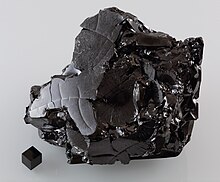
Back كربون زجاجي Arabic Стъкловъглерод Bulgarian Skelný uhlík Czech Glaskohlenstoff German Carbono vítreo Spanish Klaasjas süsinik Estonian کربن شیشهای Persian Carbonio vitreo Italian ガラス状炭素 Japanese Glaskuelestoff LB


Glass-like carbon, often called glassy carbon or vitreous carbon, is a non-graphitizing, or nongraphitizable, carbon which combines glassy and ceramic properties with those of graphite. The most important properties are high thermal stability, high thermal conductivity, hardness (7 Mohs), low density, low electrical resistance, low friction, extreme resistance to chemical attack, and impermeability to gases and liquids. Glassy carbon is widely used as an electrode material in electrochemistry, for high-temperature crucibles, and as a component of some prosthetic devices. It can be fabricated in different shapes, sizes and sections.
The names glassy carbon and vitreous carbon have been registered as trademarks, and IUPAC does not recommend their use as technical terms.[1]
A historical review of glassy carbon was published in 2021.[2]
- ^ Cite error: The named reference
iupacwas invoked but never defined (see the help page). - ^ Uskoković, Vuk (2021). "A historical review of glassy carbon: Synthesis, structure, properties and applications". Carbon Trends. 5: 100116. Bibcode:2021CarbT...500116U. doi:10.1016/j.cartre.2021.100116. S2CID 241718868.
© MMXXIII Rich X Search. We shall prevail. All rights reserved. Rich X Search